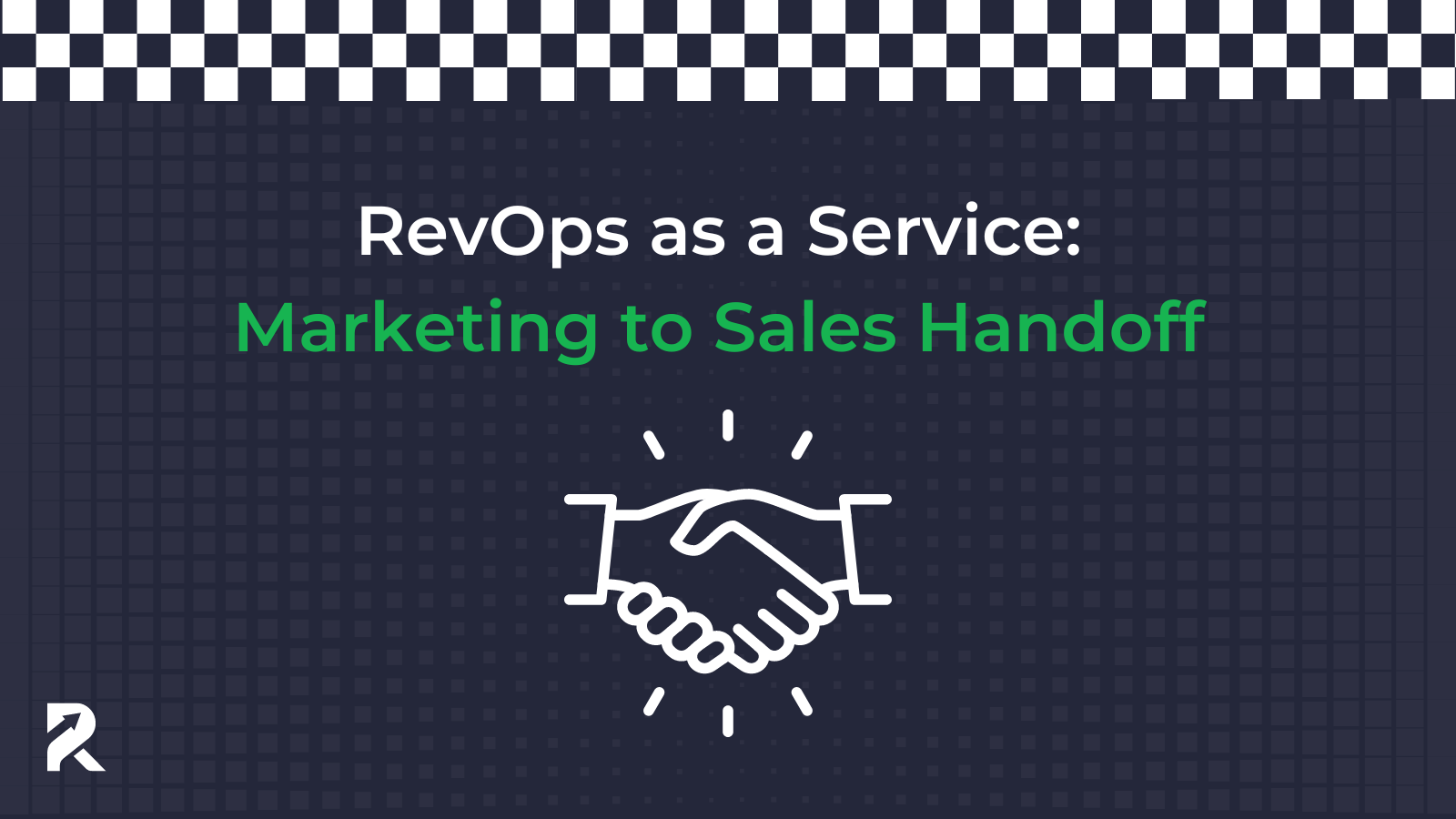
The Rise of RevOps
You can debate all day long over what the proper definition for revenue operations (”RevOps” ) is, but there is no debate when it comes to whether or not it’s a hot term.
Businesses have certainly become aware of the importance of aligning their operating functions of sales, marketing, and service and finding ways to replicate and repeat revenue growth.
So does that mean every business now has a Head of Revenue Operations or a VP of Sustainable Revenue Growth? Well, not exactly. While almost every (successful) company on the planet recognizes the need for prioritizing revenue operations, there is a marked difference in how they are choosing to address it.
Some businesses have a Chief of RevOps who is a wizard with models and GTM motions coupled with a devoted set of employees who do nothing but eat, sleep, and breathe sweet RevOps air. But many do not. In fact, for most businesses, it can be difficult to even know what a revenue operations person (or team) should be doing.
Enter RevOps as a service.
What is RevOps as a Service?
Has your car’s oil been changed recently? If so, there’s a good chance it was done by a mechanic at a dealership or some type of auto service shop. Increasingly, people are turning to professionals when it comes to routine maintenance on their car. This is a good example of outsourcing a task.
For a business, outsourcing their revenue operations is no different: just think of RevOps as the oil, and companies which specialize in optimizing the revenue operations of a business (shameless brag: RevPartners helps drive revenue the best) as the auto service shops.
So what is RevOps as a service? Quite simply, it is when a business contracts out their revenue operations strategies to a company with an expertise in RevOps. A RevOps team will design a revenue process that works for this business and allows them to grow exponentially.
Master the Four Levers of Revenue Growth
Are you pulling the right one?
Why Outsource Tasks?
Not everything can be handled in-house. In fact, in many cases, a refusal to outsource can stunt the growth of a business. Contracting out certain tasks is often a must due to a lack of personal/in-house knowledge regarding a particular subject, a lack of overall resources, and can often be cheaper, especially if you don't know what you’re doing and subsequently end up burning your most precious resource (time).
Areas/Topics Assessed
Here are some examples of the areas a company offering RevOps as a service may look at while mapping out the RevOps strategies and processes for a business:
- Net revenue retention
- Forecasting and goalslif
- Sales stages
- Lead status
- Lead scoring
- Sales sequences
- Customer lifecycle stages
Let’s take a look at that last one and see how it might be tackled by a team of RevOps pros.
Customer Lifecycle Stages
Watch the full video series: Building a RevOps Engine in HubSpot - with Frank Devine
What is it?
One of the immediate benefits of having RevOps experts handle your revenue processes is that they can provide clarity. Often, a business will define a particular lifecycle stage in a way that it is beneficial in a specific circumstance and then change the definition the next week. Bad idea.
Here’s a solid definition for a lifecycle stage: it is a contact or company property that notes where a customer’s current relationship is with your business, reflected as where they are in their customer lifecycle. There are the 8 stages of the customer lifecycle spanning from potential customers to existing customers to loyal customers:
- Prospect/Lead: A person who expresses interest by visiting a website or other piece of content
- MQL: Marketing Qualified Lead, a person who expresses interest in a product or service and fits the target profile
- SQL: Sales Qualified Lead, a person who experiences a pain and wants to take action
- SAL/Opportunity: Sales Accepted Lead, verified by the sales team as benefiting from the impact
- Commit/Customer: Mutual commitment to deploy a solution that will achieve impact at a set time
- Live: Client has been onboarded on time, within budget, and the solution can deliver impact
- MRR: Solution delivers impact again and again, and a recurring revenue stream is secured
- LTV: Revenue generated over the lifetime of the account; net of churn, including growth
Trigger Examples
When it comes to customer lifecycle management, a team of RevOps experts will use specific actions (triggers) completed by the customer to determine when movement is appropriate. Here are some examples for each of the stages:
- Prospect/Lead: List upload, Target outbound list, Engagement, but not MQL lead score
- MQL: Form submission, Lead score threshold, Event contact
- SQL: Demo request, Discovery meeting booked, Conversation at event
- SAL/Opportunity: Contact associated to deal
- Commit/Customer: Contact is associated to closed won deal
- Live: Customer has completed kickoff call
- MRR: Customer cross-sold from NRR to MRR, Customer completes first term
- LTV: Customer is in 2nd+ term and has no specific contract end date (loyalty stage)
This process will also be beneficial in determining when one team should hand-off to another. For example, the marketing team will typically hand-off to sales at the SQL stage and sales will typically hand-off to the customer service/customer success team at the Commit/Customer stage. Having a solid understanding of the triggers for these stages will reduce friction during these key hand-off periods and help to increase customer retention rates.
Why are They Important?
Tracking customer lifecycle stages is beneficial because it gives visibility into where leads are in the buying process, improves the handoff between departments (primarily sales and marketing), and creates the ability to segment leads and customer types to deliver target communication.
Guidelines
To maximize how customer lifecycle stages are used in HubSpot, the team of RevOps experts will typically have a set of guidelines which will inform their decision-making. Here a some examples with descriptions:
- Model agreement (know how your lifecycle should be set up for maximum success)
- Codified definitions (changes to stage definitions are made only in exceptional circumstances)
- Universal usage (every contact in HubSpot should have a lifecycle stage)
- Progression, not regression (no contact can move backwards…you can reset and push through stages again, but you overwrite your timestamp dates)
- No skipping (no contact can skip a stage as this will result in it not being in the funnel report)
- Know the timeline (all stages must have a timestamp)
Roadmap
When it comes to correctly setting up customer lifecycle stages, a team of RevOps experts will often work in phases.
Phase 1 will often include:
- Defining stages and triggers
- Aligning the triggers
Phase 2 gets into the actual processes:
- Build lists, workflows, and funnel reports
- Reset stages
- Turn on workflows
- Ensure correct stage automation for future contacts
Phase 3 wraps up with:
- Roll out process to the team
- Constant monitoring to make sure flow is working
What Will Success Look Like?
When customer lifecycle stages are properly mapped out, here’s what you can expect:
- See the “before and after” of your Contact Funnel Conversion Rate report and enable future reporting
- Get a correct baseline conversion rate between the key stages of your customer journey
- Reduce incorrect data and manual updating through Lifecycle Stage auto updates
Reporting Examples
If You Want the Best
Unless you really, really know what you’re doing, changing your car’s oil on your own can be a disaster. Likewise, unless you really, really know what you’re doing, handling your own revenue operations processes can be like pouring oil into your transmission (if you don't know, this is a terrible idea). Next time, partner with RevPartners for all your RevOps needs.
Here’s a great example of the “RP Difference” in action…
Recent Problem Encountered by Partner
Individual contacts from the same company are often in different lifecycle stages, causing the company to show up in multiple progression stages. Essentially, a duplicating company was giving the sales team false positives.
Our Solution
One of our strategists created a company list from contact lifecycle stage lists and filtered to select contact in the highest stage.
They then built a report showing contact conversion rates, count of company, and progression from MQL, SQL, and Opp week over week.
What’s the Bottom Line?
We win when you win…and we ain't in the mood to lose.
Want to learn if you're doing RevOps well?
Check out our 5 stage revenue maturity model



